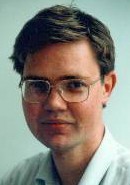Timo Kaukoranta

Abstract
This page is dedicated to the memory of my colleague Timo Kaukoranta.
I have had great pleasure to work with him in research for many years
before he suddenly passed away in December 2002. His strongly analytical
and objective way of thinking flavored by a needful drop of a good
sense of humor still inspired me in studying clustering algorithms
beyond what no other man has done before.
History
Study time:
I started my studies in the Department of Computer Science at the
University of Turku, 1987. There were about 35 new students in total.
In my opinion, this group was very good and progressive considering
that among about 20 graduates (MSc) five of us have completed PhD
since then (me, Antti, Timo, Antero, Jaakko) and I think there will
be even more.
Anyway, during the second academic year, I started to do lots of
co-operation with Timo. Firstly some small project works in the
courses such as Information Systems and Operational Analysis, and
later larger project works such Motti - The Game, which was
not only a great strategy game but also the ultimate software
engineering school for me and Timo. We spent enourmous time and
had long and endless debates about how programs should be written,
and we agreed that the result of this project was far from perfection
but we anyway aimed at it. As a side-product, only then we really
learnt how to make software.
Two PhD theses:
In 1991, I graduated one year ahead of the schedule and first from the
1987 student group. I went to industry for about 5 months but then my
supervisor Olli Nevalainen convinced me to come back and start PhD
studies. The idea was a little bit shock to me at first. But I anyway
started research on Image Compression in January 1992 under Olli's
supervision. Sometime later in 1993, I realized that Timo was stucked
with the choice of topic for MSc thesis. I then managed to convince
him to start it with the same topic that I was working on. As a result,
we teamed up again and he ended up doing his MSc Project from the results
of programming all the wildest ideas I was desperately trying to do alone
at first.
I then completed and defended my PhD Thesis Block Coding in Image
Compression in 1994, in which Timo contributed by co-authoring two
important papers: the BTC survey paper, and the one about using
vector quantization.
In 1994, Timo completed his MSc and, not surprisingly, immediately
started to work towards his PhD on clustering algorithms for vector
quantization. It was then quite natural that we continued the research
co-operation within our excellent group including me, Timo and Olli
Nevalainen. As a result, we published seven high quality journal articles
including two IEEE transaction publications. In 1999, Timo defended his
PhD thesis Iterative and hierarchical methods for codebook generation
in vector quantization. At this time, I had already moved to Joensuu
but we managed to maintain our co-operation.
Post doctoral:
Soon after Timo's dissertation Timo visited Joensuu to give presentation
in our Research Seminar. For most of the audience, the topic was quite
theoretical and I was not really waiting big enthusiasm towards the
results. But as usually, good work cannot be left unnoticed. Particularly
Olli Virmajoki kept asking questions about the algorithms well beyond the
normal level of interest. It then happened that Olli started to work his
PhD research inspired by Timo's presentation. During this work, Timo
co-authored in one journal and two conference articles. Olli's thesis
will be defended in December 2004.
Prologue:
Even though my relationship with Timo has been mostly work-related,
I have to say that he was much more to me than just a collague, he was
a friend. After all, we spent most of our study time together, and
continued the co-operation about 14 years! Working with Timo was
always a great pleasure for me because of his strongly objective
and analytical attitude towards the problems we tried to solve at the
times. Even if some idea that we had been trying to make work for weeks,
turned out to be failure, he never looked back with frustration but
instead, he was always already thinking how to solve the problem in the
light of the new situation. Very good approach that I would call
solution-based thinking opposite to problem-based thinking.
His healthy critical realism also greatly compensated my somewhat
too idealistic and optimistic point of view at times. I assume that
Timo's other friends can say the same that he was very pleasant to
work with and come along with him. Our co-operation resulted quite
a many scientific papers, which are maybe just a small drop in the
Ocean of Science, but for me they represent something special, work
that was really enjoyable to make, and pieces of work that I can
still be proud of.
All the best to Timo wherever you are, and his friends who are missing him!
